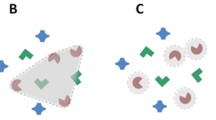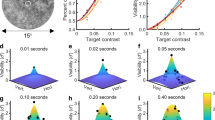Abstract
We construct a mathematical model indicating the information available to the observer regarding each item in a spatial unit in the visual scene, at any given moment, dependant on previous fixations and eye movement scanpath. Dividing the items in the visual scene into discrete units, two processes affect the amount of information available about each unit at each time: an incremental component and a memory decay component. We assume that extracted information is incremented for a scene unit each time the fixation falls on it and increases as a sigmoid or exponential growth function with subsequent fixations and that information decays exponentially between recurring fixations on a unit. Results show that the amount of available information grows and fluctuates stochastically, varying from unit to unit and from time to time, so that complete information is never reached for the entire scene. Simulations show that the larger the scene, the less information is available, on average, for each scene unit, though more may be available in total, as well as more for favored units. The resulting dynamics of this local available information measure might predict the probability of perceiving a change in stimulation at a corresponding visual unit or its complementary, the probability of change blindness.







Similar content being viewed by others
Abbreviations
- VSTM:
-
Visual short-term memory
References
Antes JR. The time course of picture viewing. J Exp Psychol. 1974;103:62–70.
Atkinson RC, Shiffrin RM. Human memory: a proposed system and its control processes. In: Spence KW, Spence JT, editors. The psychology of learning and motivation, vol. 2. New York: Academic Press; 1968. p. 89–195.
Avrami M. Kinetics of phase change. I. General theory. J Chem Phys. 1939;7:1103–12.
Avrami M. Kinetics of phase change. II. Transformation–time relations for random distribution of nuclei. J Chem Phys. 1940;8:212–24.
Avrami M. Kinetics of phase change. III. Granulation, phase change, and microstructure. J Chem Phys. 1941;9:177–84.
Ballard DH, Hayhoe MM, Pook PK, Rao RP. Deictic codes for the embodiment of cognition. Behav Brain Sci. 1997;20:723–67.
Bruce NDB, Tsotsos JK. Saliency, attention, and visual search: an information theoretic approach. J Vis. 2009;9(3):5, 1–24. http://www.journalofvision.org/9/3/5/. doi:10.1167/9.3.5.
Buswell GT. How people look at pictures. Chicago: University Chicago Press; 1935.
Dodd MD, Van der Stigchel S, Hollingworth A. Novelty is not always the best policy: inhibition of return and facilitation of return as a function of visual task. Psychol Sci. 2009;20:333–9.
Feldman JA. Four frames suffice: a provisional model of vision and space. Behav Brain Sci. 1985;8:265–89.
Erofe’ev BV. Generalized equation of chemical kinetics and its application in reactions involving solids. C R Acad Sci USSR. 1946;52:511–4.
Hochstein S, Ahissar M. View from the top: hierarchies and reverse hierarchies in the visual system. Neuron. 2002;36:791–804.
Hollingworth A, Williams CC, Henderson JM. To see and remember: visually specific information is retained in memory from previously attended objects in natural scenes. Psychon Bull Rev. 2001;8:761–8.
Horowitz TS, Wolfe JM. Visual search has no memory. Nature. 1998;394:575–7.
Irwin DE. Information integration across saccadic eye movements. Cogn Psychol. 1991;23:420–56.
Irwin DE. Visual memory within and across fixations. In: Rayner K, editor. Eye movements and visual cognition: scene perception and reading. New York: Springer; 1992. p. 146–65.
Irwin DE, Andrews R. Integration and accumulation of information across saccadic eye movements. In: Inui T, McClelland JL, editors. Attention and performance XVI: information integration in perception and communication. Cambridge, MA: MIT Press, Bradford Books; 1996. p. 125–55.
Irwin DE, Yantis S, Jonides J. Evidence against visual integration across saccadic eye movements. Percept Psychophys. 1983;34:49–57.
Jacob M, Hochstein S. Comparing eye movements to detected vs. undetected target stimuli in an identity search task. J Vis. 2009;9(5):20, 1–16. http://www.journalofvision.org/9/5/20/. doi:10.1167/9.5.20.
Jacob M, Hochstein S. Graded recognition as a function of the number of target fixations. Vis Res. 2010;50:107–17.
Johnson WA, Mehl RF. Reaction kinetics in processes of nucleation and growth. Trans AIMME. 1939;135:416–42.
Loftus GR, Mackworth NH. Cognitive determinants of fixation location during picture viewing. J Exp Psychol Hum Percept Perform. 1978;4:565–72.
Mackworth NH, Morandi AJ. The gaze selects informative details within pictures. Percept Psychophys. 1967;2:547–52.
Najemnik J, Geisler WS. Optimal eye movement strategies in visual search. Nature. 2005;343:387–90.
Nodine CF, Carmody DP, Kundel HL. Searching for nina. In: Senders JW, Fisher DF, Monty RA, editors. Eye movements and the higher psychological functions. Hillsdale, NJ: Erlbaum; 1978. p. 241–57.
O’Regan JK. Solving the “real” mysteries of visual perception: the world as an outside memory. Can J Psychol. 1992;46:461–88.
O’Regan JK, Levi-Schoen A. Integrating visual information from successive fixations: does trans-saccadic fusion exist? Vis Res. 1983;23:765–8.
O’Regan JK, Rensink RA, Clark JJ. Change blindness as a result of “mudsplashes”. Nature. 1999;398:34.
Renninger LW, Coughlan J, Verghese P, Malik J. An information maximization model of eye movements. Adv Neural Inf Process Syst. 2005;17:1121–8.
Rensink RA. The dynamic representation of scenes. Vis Cogn. 2000;7:17–42.
Rensink RA. Seeing, sensing, and scrutinizing. Vis Res. 2000;40:1469–87.
Rensink RA, O’Regan JK, Clark JJ. To see or not to see: the need for attention to perceive changes in scenes. Psychol Sci. 1997;8:368–73.
Simons DJ, Levin DT. Change blindness. Trends Cogn Sci. 1997;1:261–7.
Simons DJ, Levin DT. Failure to detect changes to people in real-world interaction. Psychon Bull Rev. 1998;5:644–9.
Trommershäuser J, Glimcher PW, Gegenfurtner KR. Visual processing, learning and feedback in the primate eye movement system. Trends Neurosci. 2009;32:583–90.
Wolfe JM. Inattentional amnesia. In: Coltheart V, editor. Fleeting memories. Cambridge: MIT Press; 1999. p. 71–94.
Yarbus AL. Eye movements and vision. New York: Plenum; 1967.
Acknowledgments
We thank Prof. Isaac Jacob for suggesting the nucleation-and-growth kinetics. This study was supported by grants from the Israel Science Foundation (ISF) and the US-Israel Binational Science Foundation (BSF).
Author information
Authors and Affiliations
Corresponding author
Electronic supplementary material
Below is the link to the electronic supplementary material.

12559_2010_9084_MOESM1_ESM.gif
Model dynamics. With each fixation, information is extracted from the fixated unit so that its available information increases, and previously extracted information at other units is decreased. Simulation shown for 150 fixations with fluctuating available information for each visual scene unit (top) and change in available information for the most fixated unit (bottom; marked by black border in top); a = 1; c = 2; k = 0.02; number of units = 30 (see “Methods”, Eqs. 1, 3). Each fixation is indicated by a red dot. Note increase in information up to the sigmoid curve (bottom) when a fixation falls on the most fixated unit. See text for explanation of 4 steps in calculating the available information; see Fig. 2c, for another simulation example (GIF 1.85 MB)

12559_2010_9084_MOESM2_ESM.gif
Change in probabilities for fixating each unit, along a sequence of 10 fixations, due to inhibition and facilitation of return. Shown initially are the baseline probabilities (each favored unit—0.075; non-favored—0.018, described in the “Methods”). With each fixation, the calculated probabilities for the next iteration are shown, including a memory trace of the last 3 fixationst (GIF 111 kb)
Appendices
Appendix 1: Algorithmic Representation of the Model
The principal algorithm of the proposed model is described below. Each variation in the simulation, such as biased probability of fixations and biased decay rate, would impose an appropriate variation on the algorithm.

Appendix 2: Algorithm for Determining Model Parameters Following a Change Detection/Change Blindness Experiment
The following algorithm is designed to output the optimal parameters of the model, which best fit change detection experimental data. The algorithm is based on the observation that the result of each experimental trial is a dichotomy, either detection or miss, while the model predicts the available information, which we assume is directly related to the detection probability. The available information is related to the probability of change detection by some transformation, which is here considered included in the formula for available information so that the available information is measured in units of predicted detection probability. Hence, to compare the experimental results with the model predictions, the algorithm suggests grouping trials according to their ranges of predicted detection probability as obtained by the model, allowing calculation of a single detection probability for the trials in each range (by averaging their results) and comparing this probability with the model predictions. The match between experimental and predicted values will indicate degree of fit of the parameters.
The algorithm works as follows: Part I outputs the detection probabilities for each trial, as calculated by the model (on the basis of the fixation sequence of these trials), corresponding to all permutations of parameters. Part II, the core of the algorithm, calculates the experimental detection probability for the trials that fall in a certain probability range obtained by the model (in Part I) and then calculates the deviations between the experimental results and the model predictions, for each set of parameter permutations and for each bin of probability range. It then calculates the norms of the deviation vectors and outputs the optimal parameters, those with the minimal deviation. This is the output of the algorithm. Actually, Part II could be merged into Part I, but is shown separately for clarity. In general, the algorithm can either be applied separately for each individual observer using only his/her results or applied over all subjects together, pooling all trials. Note also that the parameter bins could be assigned finer values for more precise results.



Rights and permissions
About this article
Cite this article
Jacob, M., Hochstein, S. Gathering and Retaining Visual Information Over Recurring Fixations: A Model. Cogn Comput 3, 105–123 (2011). https://doi.org/10.1007/s12559-010-9084-x
Received:
Accepted:
Published:
Issue Date:
DOI: https://doi.org/10.1007/s12559-010-9084-x




